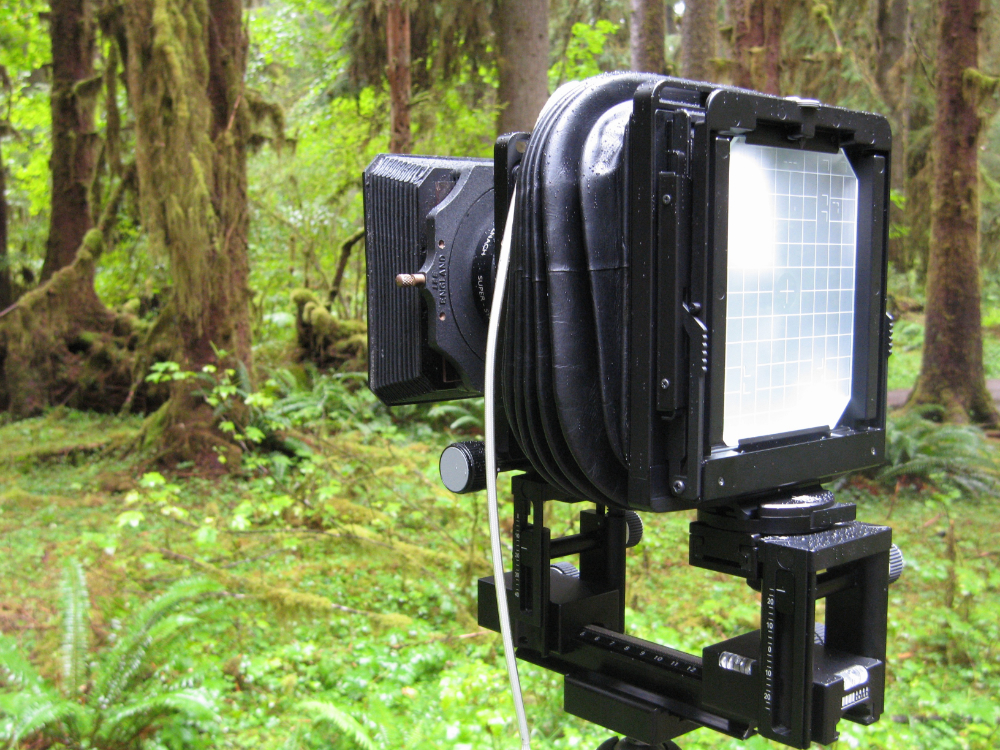
Review: Arca-Swiss F-Universalis 4×5 by Mark Darragh
Arca-Swiss has been among the most innovative of the major view camera manufacturers, embracing the digital photography revolution whilst still maintaining a strong presence in the large format film camera market. The Universalis series of cameras are a modular system with the capability of using mirrorless cameras, DSLRs, medium format digital backs and also 120mm and 4×5 film depending on the configuration of the bellows and camera back.
I’ll state from the outset that I am a longterm Arca-Swiss user, particularly the F-Field which has been my primary 4×5 camera for many years. I have also owned and used everything from wooden folding cameras through to fully geared 8×10 studio heavyweights so my experience is certainly not limited to Acra-Swiss cameras.
If you are reading the View Camera Australia blog, likely your interest is in film photography so from here on I’m going to deal specifically with the Arca-Swiss Universalis as a 4×5 film camera.
Out of the box
In a basic sense, the Universalis 4×5 could be described as a lighter, stripped down version of the F-Field 4×5. The Universalis 4×5 ships with 110mm front and 141mm rear standards and a 30cm leather conical bellows. A longer 60cm synthetic bellows is also available. The standard rail which comes with the camera is a 25cm fixed rail.
The camera back is a Graphlock compatible system. Viewing is by means of an Arca-Swiss ground glass/fresnel lens combination which comes with a hard plastic removable cover as standard.
Swing and tilt (Arca’s Orbix Micrometric tilt) are only available on the front standard which also has rise/fall. The rear standard has rise/fall and shift. All movements are geared except the front swing and front focus. Unlike the Arca-Swiss F-Line series which have the rise/fall as part of the format frames, the Universalis cameras are similar to the Arca Swiss M-Line series where all the movements are incorporated into the standard bearers or function carries as Arca Swiss call them.
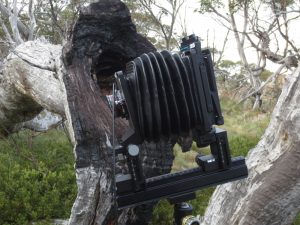 For a 4×5 camera, the 25cm rail on its own is not particularly practical. Unless you never use a lens longer than about 135mm, you would need to add an extension rail (Arca-Swiss make 15cm and 25cm extension rails) or buy a longer folding or telescoping rail. I have been using the Universalis with either a 30cm folding rail or 30cm telescoping rail (comprised of two 15cm pieces), depending on where I’m intending to use the camera and the lenses I’m carrying with it. Pictured: Arca-Swiss Universalis in use with 30cm telescoping rail.
For a 4×5 camera, the 25cm rail on its own is not particularly practical. Unless you never use a lens longer than about 135mm, you would need to add an extension rail (Arca-Swiss make 15cm and 25cm extension rails) or buy a longer folding or telescoping rail. I have been using the Universalis with either a 30cm folding rail or 30cm telescoping rail (comprised of two 15cm pieces), depending on where I’m intending to use the camera and the lenses I’m carrying with it. Pictured: Arca-Swiss Universalis in use with 30cm telescoping rail.
With the 30cm folding rail and ground glass protector in place the weight comes in at approximately 2.1 kg. The telescoping rail adds another 300 grams or so. Pictured: Arca-Swiss Universalis in use with 30cm telescoping rail.
In the field
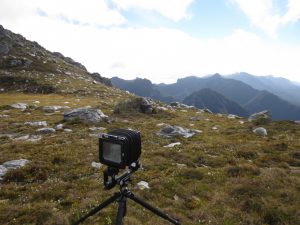 In its seven or so months with me, the Universalis has endured steady rain and humidity in the Olympic Forests of Washington, USA; 100 km/hr gales in the Victorian Alps and been hauled on a 9 day trip through the Western Arthur Range in South West Tasmania, to name a few trips. In other worlds, as a field camera it has had a pretty thorough test run in some very rugged and demanding conditions. Pictured: Photographing in the Western Arthur Range, South West Tasmania.
In its seven or so months with me, the Universalis has endured steady rain and humidity in the Olympic Forests of Washington, USA; 100 km/hr gales in the Victorian Alps and been hauled on a 9 day trip through the Western Arthur Range in South West Tasmania, to name a few trips. In other worlds, as a field camera it has had a pretty thorough test run in some very rugged and demanding conditions. Pictured: Photographing in the Western Arthur Range, South West Tasmania.
Stored on the 15cm rail or 30cm folding rail, the camera is extremely compact for a metal monorail. In fact it rivals many wooden or metal flatbed cameras in this regard. It is also very quick and easy to setup. With an appropriate lens stored in place (I usually have either 150mm or 90/80mm, my most used lenses), once the camera is out of it’s bag it is simply a matter of attaching the rail to the tripod using an Arca Swiss compatible clamp, leveling the camera and then racking the standards to the approximate extension. One feature I found very helpful are the spirit levels on the rear function carrier.
These are set close together so, in most cases, you can see both a these simultaneously which means the camera can be leveled very quickly.
There are at least a couple of ways of centering a lens on the camera. The first is to raise the front standard fully in which case the back needs 25mm of rise. This will limit you to front fall of 40mm and rear rise/fall +- 25mm. One other possibility is to have the rear standard fully lowered and the front standard with 10mm of rise. This gives you 30mm front rise and 10mm of fall while the back can give 50mm of rise (equivalent to front fall). I prefer the later as I can store the camera more compactly with the lens already centered. The rear shift is 25mm either way. Pictured: Rear function carrier with spirit-levels.
In use all the movements, geared or friction, are smooth and precise. The design and layout of the Universalis is in keeping with the generally design of Arca-Swiss cameras, so for me, using it has quickly become intuitive. The fact that most of the movements are self locking and adjusted by simply turning a knob means they are easy to use even when wearing moderately thick gloves. This has been a real bonus in cold conditions compared to trying to adjust friction movements and then tighten screw-locks with bare, numb fingers.
 Although I don’t do much long lens work, I regularly use my 4×5 cameras for close up and macro photography. It was this sort of photography that steered me from using wooden or metal flatbed cameras toward metal monorails over 15 years ago. Given the close camera to subject working distances and long bellows extension usually involved, I have generally prefer to work with back movements. Obviously you can’t use what you don’t have so using the Universalis in these situations has called for a change in my approach. Thankfully the design and precise construction of the Universalis means that reaching forward and performing fine adjustments with one hand whilst focusing and holding a loupe under a dark cloth is relatively straightforward. Pictured: Arca-Swiss Universalis at work with a macro subject.
Although I don’t do much long lens work, I regularly use my 4×5 cameras for close up and macro photography. It was this sort of photography that steered me from using wooden or metal flatbed cameras toward metal monorails over 15 years ago. Given the close camera to subject working distances and long bellows extension usually involved, I have generally prefer to work with back movements. Obviously you can’t use what you don’t have so using the Universalis in these situations has called for a change in my approach. Thankfully the design and precise construction of the Universalis means that reaching forward and performing fine adjustments with one hand whilst focusing and holding a loupe under a dark cloth is relatively straightforward. Pictured: Arca-Swiss Universalis at work with a macro subject.
The leather pleated bellows is one of the outstanding features of the camera.
It is well constructed and robust yet supple enough not to restrict movements when using shorter focal length lenses. The design is biconical which means they fold extremely compactly when the standards are brought close together. One little point worth noting, when closed, the edge of the bellows extend past the frames so they are potentially vulnerable to damage should you be careless in how the camera is transported.
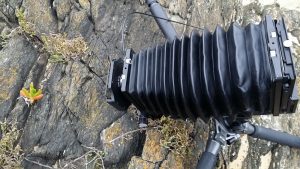 With the conical bellows and appropriate length rail, I have found the Universalis 4×5 easily useable with a focal length range from 47mm through to 300mm. With shorter focal lengths from 47 – 65mm you will certainly reach the limit of coverage of the lenses without the bellows causing any restriction. At long extensions the camera is as rigid and stable as you could hope for given its relatively light weight. If I was regularly using the camera for long lens or closeup work my preference would be to use the Arca-Swiss 30cm telescoping rail which I find to be more stable at long extensions than the folding rail. The heaviest lens I have used on the Universalis so far is a Nikkor 90 mm SW f4.5 which is a reasonably hefty 600 grams and probably at the upper end of what most people would use on a 4×5 camera in the field. Even in some quite windy conditions I found the camera has handled the weight well with no issues with flex or movement. Pictured: Arca-Swiss conical leather bellows.
With the conical bellows and appropriate length rail, I have found the Universalis 4×5 easily useable with a focal length range from 47mm through to 300mm. With shorter focal lengths from 47 – 65mm you will certainly reach the limit of coverage of the lenses without the bellows causing any restriction. At long extensions the camera is as rigid and stable as you could hope for given its relatively light weight. If I was regularly using the camera for long lens or closeup work my preference would be to use the Arca-Swiss 30cm telescoping rail which I find to be more stable at long extensions than the folding rail. The heaviest lens I have used on the Universalis so far is a Nikkor 90 mm SW f4.5 which is a reasonably hefty 600 grams and probably at the upper end of what most people would use on a 4×5 camera in the field. Even in some quite windy conditions I found the camera has handled the weight well with no issues with flex or movement. Pictured: Arca-Swiss conical leather bellows.
One benefit I have found over the F-Line Field is that the lens boards sit flush with the front standard rather than being recessed behind the up rights of the format frame. In practice this means it is a little easier to reach the shutter and aperture controls of lenses with a large front element, when using a recessed lensboard or when using a centre ND filter or 100mm filter holder such as the Lee system.
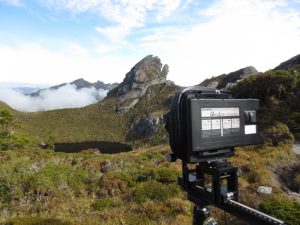 The viewing on the Arca-Swiss ground glass/fresnel is as good as I have used with this combination. In general I have found the spring backs on Arca-Swiss cameras to be quite tight (not a bad thing actually) and the Universalis is no exception. A standard double darkslide is happily accommodated but when using anything thicker, such as a Fuji Quickload holder, I find it easier to remove the groundglass and attaching the holder via the Graphlock system. Pictured: Arca-Swiss graphlock back with Fuji Quickoad holder.
The viewing on the Arca-Swiss ground glass/fresnel is as good as I have used with this combination. In general I have found the spring backs on Arca-Swiss cameras to be quite tight (not a bad thing actually) and the Universalis is no exception. A standard double darkslide is happily accommodated but when using anything thicker, such as a Fuji Quickload holder, I find it easier to remove the groundglass and attaching the holder via the Graphlock system. Pictured: Arca-Swiss graphlock back with Fuji Quickoad holder.
Niggles
Finish. Overall the camera is well finished. However on my camera I have noticed that the anodising on the rear format frame has quickly worn through to the metal in a couple of places with no obvious reason for the wear. This may just be an issue with this one component as the anodising on the rest of the camera seems to be very tough, in keeping with what I have found true of other Arca-Swiss products.
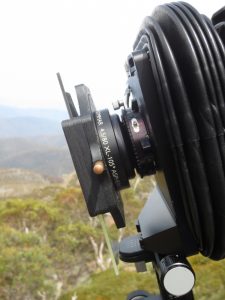 Duck bill When using 4×6” (100x150mm) filters in some cases the “duck bill”, which holds the front format frame to the function carrier, can interfere with the filter placement.
Duck bill When using 4×6” (100x150mm) filters in some cases the “duck bill”, which holds the front format frame to the function carrier, can interfere with the filter placement.
This is more likely to be a problem if you are using some front tilt which is a fairly likely scenario for landscape photographers. Rod Klukas of Arca-Swiss America suggests using a large setup ring to avoid the problem. This could work in many instances but may also introduce the risk of vignetting with some wide angle lenses. I often carry a couple of Schneider 4×4” grad filters which I have used in place of my Lee 4×6” filters in situations where interference with the filter placement might be an issue. Pictured: The “duckbill” on the front standard showing potential interference with Lee ND grad filter.
In conclusion
After more than eight months of extensive use, I am very impressed by the Universalis 4×5. The designers at Arca-Swiss have obviously put a great deal of time and thought in to designing what is a well crafted and engineered camera. As a view camera which has been designed for field or location work, it is as robust and weatherproof as any 4×5 design I am aware of.
On this basis alone, as a stand alone light weight 4×5 camera, the usability and precision of the Arca-Swiss Universalis make it a camera worthy of serious consideration. When you add the modular nature of the Universalis system, let alone compatibility with the larger Arca-Swiss system, you have an extremely versatile camera platform which can be used with both traditional film and newer digital formats.
The Arca-Swiss Universalis 4×5 has definitely become my camera of choice for all but the most extreme walking and climbing trips and I look forward to carrying it on many more journeys in the years to come.

Leaf and Pebbles, Rialto Beach, Olympic National Park, WA, USA
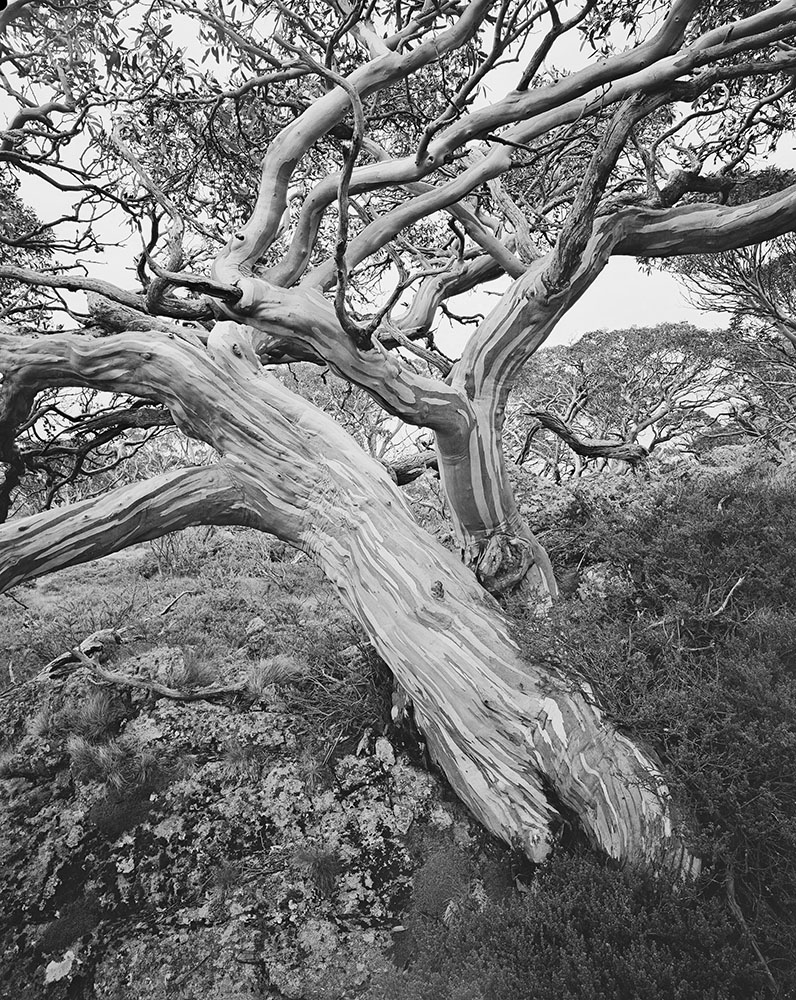
Old growth Snow Gum, Cobberas Wilderness Area, Victorian Alps

Western Arthur Range, South West World Heritage Area, Tasmania
More of Mark Darragh’s photography can be seen on his website.




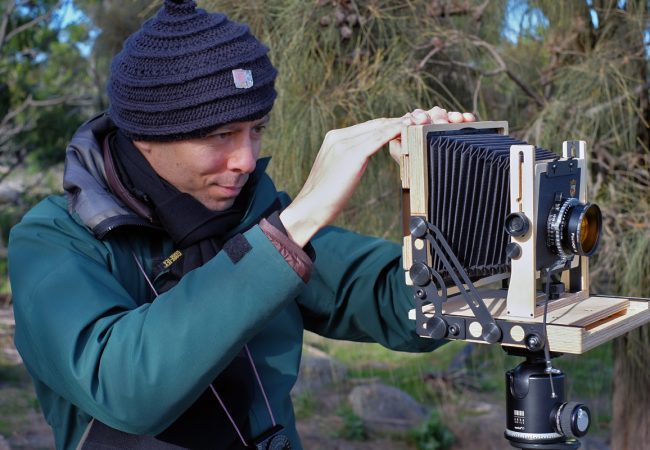
Hi. Could use your advice/suggestions regarding this camera as I am new to 4 x 5…Ric Savid 727-442-5501. Thanks.
Hi Mark,
Thanks for the review of the camera. I’m currently looking to purchase this camera & my dealer has mentioned the camera is on the delicate side, suggesting that the MF2 made by Arca also might be a sturdier design for someone looking carry the camera around in a backpack. Have you had any problems with yours traveling and hiking?
Hello Tom,
I hope you found the review useful. Delicate is certainly not an expression I would use to describe the Universalis. While relatively lightweight, the camera is very well engineered and robust. As mentioned in the review, I have carried it into some quite remote and demanding terrain and it has endured some pretty extreme weather too. If you are after a light metal view camera for field use, in my experience, the Universalis is as good as it gets.
Given you are considering the MF2, I gather you are looking at a camera for digital use. I haven’t used the MF2, but the only major difference to the Universalis is the addition of geared swing which may be of benefit to you using digital sensors. As far as I am aware, the MF2 is not available with a 4×5 option unless you purchase the necessary components separately.
All the best
Dear Mark,
thank you for your review on this camera. I’m a bit in a doubt between the F line metric incl Orbix and this camera. Did you have that issue as well? I think that the camera would suit my needs for 4×5 and 6×7 however I miss a rear tilt to obtain some ‘looming’ effect if needed. On the other side, the price difference is quite large. I also use Lee 150mm filters and need eventually a bellows to use a 450mm lens towards a 50mm ish lens. What is your opinion in this?
Kind regards,
Bert
Netherlands
Thank you, Bert.
I’m fortunate to own a couple of variations of the Arca-Swiss 4×5 and, being modular, I can swap parts between them. Lately, I have been using the front standard of the Universalis and the back of the F-Line Field. One of the reasons for this is to give me the option of back tilt and swing. If you use back tilt a lot in your photography, you may find the Universalis limiting. With either camera, you would need to purchase the separate long bellows to use a 450mm lens.
The issue with larger rectangular filters only comes into play if you use lenses with a small front element. The Schneider 80mm illustrated in the article is a good example. If you have lenses such as a 90mm Super Angulon or Nikkor SW, the front elements are large enough that the filters in the holder should clear the”duckbill”.
For my personal work, if I had to pick just one of the Arca-Swiss 4x5s it would be the F-Line Field. It offers the best compromise between versatility, movements, and weight.
I hope this is of some assistance. If you have any further questions, please get in touch.
All the best